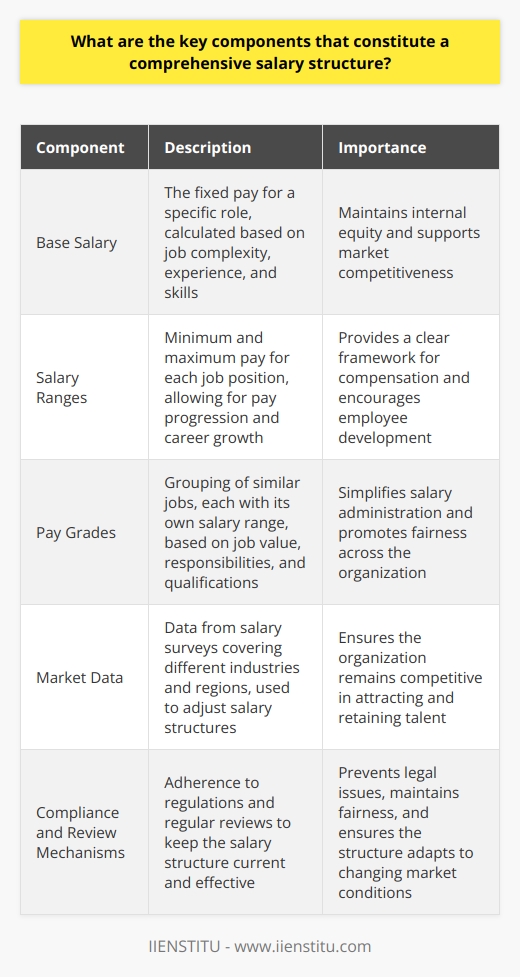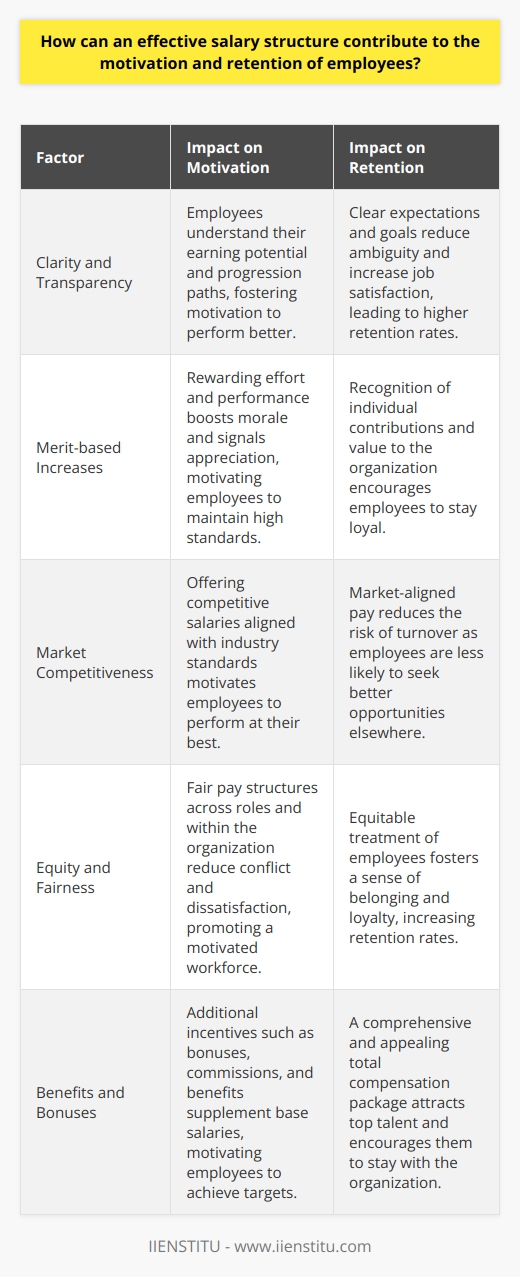
Importance of a well-crafted salary structure in today's competitive landscape
Role of salary structure in attracting and retaining talent
Beyond transactional, salary as a motivator and symbol of value
Definition of Salary Structure
Systematic approach to compensation design
Aligned with company objectives, role values, and market competitiveness
Outline of various compensation elements and payment rules
Importance and Role of a Good Salary Structure
Ensures legal compliance and internal harmony
Fosters external competitiveness
Enhances employee morale and fairness
Key Components of a Salary Structure
Basic Salary
Definition and importance as the core component
Calculation based on position, industry norms, location, etc.
Allowances
Supplementary payments for specific job-related expenses
Impact on total salary and employee motivation
Bonuses and Incentives
Significance in motivation and performance enhancement
Influence on employee retention
Benefits
Non-wage compensations like health insurance, retirement plans, etc.
Role in overall employee satisfaction and employer branding
Designing an Effective Salary Structure
Setting Priorities
Balancing business costs and employee satisfaction
Example of prioritizing flexible work arrangements over high salaries initially
Market Research
Importance of understanding market pay rates
Utilizing competitive salary data
Adjusting for Specific Roles and Skills
Importance of role-specific salaries
Impact of skills and experience on salary determination
Changing and Updating a Salary Structure
Importance of Regular Review
Adapting to market changes and addressing turnover
Process of Implementing Changes
Conducting a salary audit
Communicating changes transparently
Legal Considerations in Salary Structure
Equal Pay Act and Non-Discrimination
Understanding and complying with the Equal Pay Act
Navigating non-discrimination in compensation
Transparency in Pay
Importance and benefits of transparent pay practices
Adhering to legal requirements for transparency
Recap of the importance of a well-structured salary package
Final thoughts on maintaining an effective salary structure
Encouragement for continued learning and adaptation in salary design
Introduction
In the current competitive landscape of job markets and the ever-evolving norms of employment, a meticulously crafted salary structure serves as a keystone in an organization's remuneration policy. This comprehensive guide is crafted to elucidate the multifarious components that compile a robust salary framework, while also delineating the paramount practices to ensure its effectiveness. Salary structure extends beyond the mere transactional aspect of compensating employees for their labor; it is the lifeblood that sustains motivation, fosters job satisfaction, and ultimately becomes a crucial determinant in the attraction and retention of top-tier talent.
Definition of Salary Structure
A salary structure refers to a systematic approach to designing compensation packages that are aligned with a company's strategic objectives, the inherent value of specific roles, and market competitiveness. It is a construct that outlines the different elements of compensation — including base pay, allowances, bonuses, incentives, and benefits — and specifies the rules for payment and increments. This framework is fundamentally designed to ensure equitable, transparent, and consistent remuneration practices across an organization.
Importance and Role of a Good Salary Structure
The significance of a sound salary structure stretches to the facets of legal compliance, internal harmony, and external competitiveness. An exemplary salary policy not only adheres to legal statutes like the Equal Pay Act but also instills a sense of fairness among employees, thus bolstering workforce morale. Equally important, it equips a business to hold its ground — or outshine — rival employers, thereby attracting and retaining adept professionals in its ranks.
Key Components of a Salary Structure
Basic Salary
Definition and Importance
The basic salary constitutes the core of the salary structure, representing the fundamental rate of compensation that an employee receives for their work before any additional elements are factored in. It is the base upon which other components like bonuses and benefits are calculated. As the benchmark for statutory deductions such as taxes and social security contributions, it plays a pivotal role in the fiscal elements of employment for both the employer and the employee.
Calculating Basic Salary
Computing the basic salary involves considering a variety of factors, including the level of the position within the organization, the industry norms, geographic location, and the overarching prevailing market rates. Establishing this bedrock figure necessitates a careful balancing act, ensuring that it is attractive enough to allure skilled workers, while also aligning with the organization's budgetary constraints and financial health.
Allowances
Different Types of Allowances
Allowances are supplementary payments atop the basic salary, purposed to cover specific expenses incidental to the job. These expenses may include transportation, housing, meals, or even child care. Each allowance caters to particular needs, thus differentiating the overall compensation package by accounting for occupational exigencies or geographic cost-of-living variances.
Impact of Allowances on Total Salary
Allowances substantially affect the total salary, escalating the gross income and providing a layered remuneration structure. They are strategically utilized not just to compensate for job-associated costs, but also serve as an impetus for accepting roles that may entail additional demands, such as longer commutes or relocation.
Bonuses and Incentives
Significance of Bonuses and Incentives
Bonuses and incentives form a significant segment of a comprehensive salary structure, typically awarded for achieving predefined targets or displaying exceptional performance. They serve as a potent motivational tool, augmenting productivity and galvanizing employees towards surpassing organizational goals.
How they Influence Employee Motivation and Retention
Through recognition of individual or team triumphs, bonuses and incentives propel an environment of high performance and job satisfaction. This reinforcement not only gratifies the employee but also cultivates loyalty, significantly cutting down the turnover rates and attracting talent by showcasing the employer's commitment to meritocracy and excellence.
Benefits
Understanding Employee Benefits
Employee benefits encompass a wide range of non-wage compensations provided in addition to the basic salary and allowances. These might include health insurance, retirement savings plans, paid leave, and wellness programs. They are integral to the overall compensation package, catering to the long-term financial security and well-being of the workforce.
Role of Benefits in a Salary Structure
Benefits are a strategic component of the salary structure, offering critical support to employees while subtly conveying the employer's dedication to their holistic needs. This structural facet is not only pivotal for employee contentment but also a means to differentiate the employer in the labor market as an outstanding place to work.
Designing an Effective Salary Structure
Setting Priorities
Balancing Business Costs with Employee Satisfaction
Crafting an effective salary structure envelops a careful balance between managing the budgetary allocations of the business and fulfilling the financial aspirations of the employees. Leaders must peg the salary scales to realistic and sustainable levels that reflect the worth of the roles while also positing their operation as an employer of choice.
Example of Prioritization in Salary Structure
For instance, a startup may prioritize flexible working conditions and a vibrant workplace culture over top-dollar salaries initially, gradually ameliorating the financial aspects as the business blooms. Conversely, a well-established enterprise might affirm its dominance by offering premium salaries to secure industry-leading talent.
Market Research
Importance of Understanding Market Pay Rates
To ensconce an organization competitively, HR professionals must conduct thorough market research to derive insight into prevailing pay rates. This intel furnishes the underpinning for decisions on remuneration that confidently stand in the face of labor market scrutiny.
Utilizing Competitive Salary Data
Using accurate and current data from reliable sources such as online courses and HR certification programs, HR specialists can formulate a compelling salary structure that is both alluring to potential employees and aligned with market benchmarks. Such a strategy ensures that talent acquisition and retention efforts are not hamstrung by remuneration packages that are discrepant with industry standards.
Adjusting for Specific Roles and Skills
Importance of Role-Specific Salaries
It is imperative that the salary structure reflects the heterogeneity of roles and the diverse skill sets within an organization. A matrix that pays heed to the nuances of each position underpins the perception of equity and recognition throughout the enterprise.
Impact of Skills and Experience on Salary Determination
An effective salary scheme takes into account the distinctive expertise and tenure of each employee, fashioning compensation that is commensurate with the value brought to the company. Such an approach fosters a climate where skills advancement and professional growth are monetarily recognized, boosting morale and spurring personal development.
Changing and Updating a Salary Structure
Importance of Regular Review
To perpetuate relevance and competitiveness, a salary structure mustn't stagnate. Like the market it operates within, it must be fluid and dynamic, subject to regular review and modification in line with economic conditions and organizational priorities.
Adapting to Changes in the Market
Addressing Employee Turnover Challenges
Altering the salary framework may become imperative in the face of augmented employee turnover or shifts in the job market norms. A reactive strategy may encompass elevated basic salaries or enhanced benefits to counteract a high quit rate or to parry aggressive recruitment by competitors.
Process of Implementing Changes
Conducting a Salary Audit
Prior to embarking upon changes, a rigorous salary audit can unveil disparities and guide revisions. This diagnostic process ensures that updates are evidence-based, reinforcing the adaptability of the organization.
Communicating Changes to Employees
Executing alterations in the salary structure mandates a transparent, coherent communication strategy to convey the shifts to the workforce. Comprehensive explanations on the rationale and implications of changes not only curb uncertainty but also reinforce trust and acceptance among employees.
Legal Considerations in Salary Structure
Equal Pay Act and Non-Discrimination
Understanding and Complying with the Equal Pay Act
In the realm of salary structures, legal compliance is non-negotiable. The Equal Pay Act stipulates that men and women in the same workplace be given equal pay for equal work. Organizations thus must scrupulously design and appraise their salary frameworks to avoid violations of such statutes.
Navigating Non-Discrimination in Salary Structure
Non-discrimination extends beyond gender, enveloping all aspects of employment, including recruitment, promotions, and, crucially, compensation. Salary design must be devoid of bias, ensuring that remuneration is exclusively merit-based and does not fall foul of discrimination laws.
Transparency in Pay
Importance and Benefits of Pay Transparency
Transparency in salary practices engenders an atmosphere of trust and is a bulwark against inequity. Being forthright about compensation structures can preclude misunderstandings and foster a collegial environment where pay-related grievances are minimized.
Legal Requirements for Transparency
Several jurisdictions now prescribe a level of transparency in salary schemes, which may include provision to employees of pay ranges for their roles or the posting of such information in job advertisements. Staying on the right side of these legal stipulations not only ensures compliance but also exemplifies the organization's commitment to fairness and openness.
Conclusion
Recap of the Importance of a Well-Structured Salary Package
A cogent and distinguished salary structure is an organizational imperative in the contemporary workplace. It is the bedrock upon which talent acquisition, employee contentment, and competitive vantage are built.
Final Thoughts on Maintaining an Effective Salary Structure in a Business Setting
Preserving the potency and pertinence of a salary structure necessitates perpetual vigilance, analytics-driven recalibrations, and unwavering adherence to ethical practices. It behooves employers to remain learners in the art of remuneration, avail themselves of the latest knowledge via HR certification programs, and partake in continuous professional development.
Encouragement for continued learning about Salary Structures
Inane though it may seem, the evolution of salary structures parallels the evolution of work itself. As organizations and exemplars of industry, we must buttress our commitment to crafting salary structures that mirror our dedication to our people, our integrity, and the futures we aspire to forge — a commitment that implicates an enduring journey of discovery, education, and adaptation.
Frequently Asked Questions
What are the key components that constitute a comprehensive salary structure?
Understanding Salary Structures
A comprehensive salary structure is key. It ensures fair, consistent compensation. Various components make up this structure. These components align with organizational goals. They also adhere to market standards. Let's delve into the essential parts.
Base Salary
Base salary forms the foundation. It's the fixed pay for a role. Calculations factor in job complexity. Experience and skills also matter. Such aspects maintain internal equity. They support market competitiveness too.
Salary Ranges
Salary ranges follow next. They show minimum and maximum pay. Each job position has its own range. Ranges provide pay progression. They allow for career growth too.
Pay Grades
Pay grades group similar jobs. Each grade has a salary range. Jobs are placed based on value. They consider responsibilities and necessary qualifications. This eases salary administration. It also promotes fairness.
Market Data
Market data plays a crucial role. Employers use it to stay competitive. They adjust salary structures accordingly. This data comes from salary surveys. It covers different industries and regions.
Incentives and Bonuses
Incentives and bonuses encourage performance. These are variable pay components. They link to individual or company success. Employees see a clear reward for their efforts.
Overtime Pay
Overtime pay is for hours beyond the normal. The Fair Labor Standards Act regulates it. Only eligible employees receive it. It's usually higher than regular pay.
Benefits
Benefits are non-wage compensations. They include health insurance and retirement plans. Time off and educational assistance are also common. Good benefits can attract and retain talent.
Increment Policy
The increment policy outlines pay raises. Raises usually happen annually. Performance and market inflation influence them. Clear policies prevent discrimination. They guarantee fairness.
Compliance and Review Mechanisms
Lastly, compliance with regulations is crucial. Regular reviews keep the structure current. An outdated structure is less effective. It might even lead to legal issues.
- Understand components for a strong structure.
- Implement checks and balances.
- Keep revising and staying compliant.
A comprehensive salary structure is critical. It ensures fairness. It drives motivation. Aim for transparency and fairness. These are the pillars of a robust compensation system.

How can an effective salary structure contribute to the motivation and retention of employees?
Understanding Salary Structures
An effective salary structure is a backbone. It's a framework that outlines pay levels. It includes criteria. Criteria that determine employee compensation. This structure assesses numerous factors. Education and experience, for example. Performance and tenure too. It must adhere to market standards. Competitiveness is key here.
Motivation through Salary Structures
Clarity Breeds Confidence
Clear structures remove ambiguity. Employees understand their earning potential. They see clear progression paths. This understanding fosters motivation. Know your worth, work for more.
Recognition and Reward
Merit-based increases motivate. Perform well, earn more. It's that simple. Rewarding effort boosts morale. It signals appreciation. Recognition confirms value.
Competitive Edge
Market-aligned pay retains talent. Employees often benchmark. They compare with industry standards. Pay well, keep your staff. Lag behind, and risk turnover.
Retention via Compensation Design
Equity and Fairness
Fair pay structures are crucial. They ensure equity. Equity across roles. Equity within the organization. Fairness reduces conflict. It reduces dissatisfaction. Content employees stay longer.
Financial Security
A strong salary structure provides stability. Financial stability is a strong incentive. Financial stability keeps employees around. People seek security. They value predictable financial growth.
Benefits and Bonuses
Include incentives. Bonuses, commissions, and benefits matter. These extras attract and retain. They supplement base salaries. They make the total package appealing.
The Bottom Line
An effective salary structure does wonders. It motivates. It retains. It needs regular reviews. Adjust to the market when necessary. Tailor to individual performances too. It’s a dynamic tool. Use it. Keep your workforce engaged. Keep them satisfied. Take care of them. They will take care of your business.

What are some best practices in designing and implementing a balanced salary structure in an organization?
Understanding the Organization's Objectives
First, align the salary structure with organizational goals. It must support the company's strategic direction. Strive for consistency with the business model and culture. Ensure the structure scales with growth. Maintain flexibility for future changes.
Market Research
Consult market data regularly. Compare salaries within the industry. Adjust pay scales to stay competitive. Reflect geographic differences in living costs. Account for variations in job roles.
Job Analysis and Evaluation
Perform thorough job analyses. Establish clear job descriptions. Use evaluations to assign value to positions. Determine the complexity and responsibility levels. Understand the requirements for each role.
Ensuring Internal Equity
Promote fairness within the organization. Compare roles and responsibilities. Address any disparities in compensation. Use job evaluations to support equity. Strive for gender and race pay equity.
Creating Pay Grades
Develop distinct pay grades. Group similar jobs together. Allow for growth within each grade. Define the pay range for each level. Communicate advancement opportunities.
Linking Pay to Performance
Create performance-based incentives. Reward exceptional employee contributions. Use merit increases fairly. Set transparent performance metrics. Offer varied rewards such as bonuses.
Legal Compliance
Stay informed on labor laws. Ensure the salary structure adheres to regulations. Address minimum wage and overtime pay. Maintain compliance with equal pay laws.
Balanced Benefits Package
Offer competitive non-salary benefits. Include health, retirement, and leave options. Tailor benefits to employee needs. Recognize the value of non-monetary compensation.
Transparency and Communication
Be open about the pay structure. Communicate how the organization determines pay. Provide clear progression paths. Address employee compensation questions honestly.
Monitoring and Evaluation
Review the salary structure annually. Stay responsive to economic changes. Adapt to shifts in market conditions. Gather employee feedback regularly. Make adjustments as necessary.
By adhering to these best practices, an organization can establish a balanced salary structure that meets both business needs and employee expectations. It's about creating a fair, equitable system that rewards performance and ensures the organization's ability to attract and retain the best talent.


